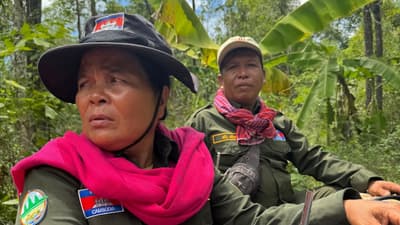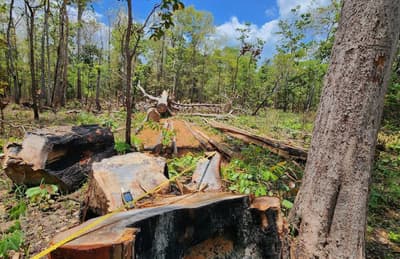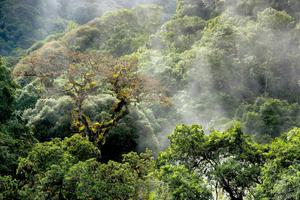Cambodia has lost more than 7 million acres of tree cover since the 2000s and has one of the highest deforestation rates in the world.
But the forest that sustains the Kuy is steadily vanishing. Vat and his fellow resin tapper, Jork Paeng, once worked more than 400 trees each; now they each have just over 100. Protecting what remains has become their community’s top priority.
Illegal logging has long plagued both Preah Roka and Prey Lang, a larger protected area to the south and the largest remaining lowland evergreen forest in Southeast Asia. Since 2001, Preah Roka has lost more than 78,000 acres — an area more than five times the size of Manhattan — while Prey Lang has seen more than 222,000 acres destroyed, according to the monitoring agency Global Forest Watch. Cambodia still retains significant forest cover, but since the early 2000s it has lost, overall, more than 7 million acres of tree cover — equivalent to a 33 percent decrease — according to the organization, and its rate of deforestation is one of the highest in the world.
Logging inside Cambodia’s protected forests is a murky enterprise — carried out, observers say, by business interests with links to government officials and smaller, individual operators. Even in Vat’s own village, people have taken part in the destruction. “We know these people,” he said. “But they’re not friends.” What is clear, observers agree, is that illegal loggers often operate with the collusion of authorities at every level.
On the front lines are grassroots patrols like the Preah Roka Forest Community Network (PFCN), which documents illegal activity using time- and date-stamped cell phone photos and GPS coordinates and posts its evidence on social media. But these efforts rarely lead to meaningful action. “[The authorities] claim they chase the loggers,” says Chhum Khim, the woman leading the PFCN patrol I joined, “but when we show them the evidence, we’re the ones who get punished.”
The risks for environmental defenders appear to have grown sharply in recent months. Just days before I entered the forest, an activist named Ma Chettra posted evidence of illegal logging in Preah Roka on social media. In response, the provincial department of the environment sent him a letter accusing him of “false information, intentionally inciting social disorder to serve the political agenda of illegal opposition groups abroad.”
Soon after, journalist Ouk Mao was arrested on unspecified charges after documenting logging in Prey Lang. “Ministry of Environment rangers [and] military forces are implementing a regime of oppression unseen in recent years,” said Marcus Hardtke, a German environmentalist who has documented illegal logging and timber trading in Cambodia for decades.
“The big trees contain a spirit,” a forest defender says, “and when the tree is [felled], that spirit is killed.”
Since the Khmer Rouge era in the 1970s, and a subsequent decade of war, Cambodia has struggled to address environmental degradation. After nearly four decades in power, former prime minister Hun Sen handed over leadership to his son, Hun Manet, in August 2023, following elections that were widely criticized for stifling all opposition.
While the government has, in recent years, taken measures to promote conservation — for example, by cracking down on illegal fishing in a country with one of the world’s highest per capita levels of fish consumption — it has shown far less resolve when it comes to tackling the powerful networks behind illegal logging. Critics say that is not surprising because those networks may in many cases be intertwined with the governmental agencies tasked with enforcing the law. And the major kingpins in organized forest crime, Hardtke said, “have by and large remained the same over the last years.”
For the Kuy people, an Indigenous and historically marginalized group in Cambodia, the forests are a source of life, culture, and survival. “Our goal is to protect the forest for the livelihoods of local people,” who stay in towns and villages just outside the forest boundaries, said Khim, the PFCN leader, adding that the forest holds spiritual meaning as well. “The big trees contain a spirit, and when the tree is [felled], that spirit is killed,” she said.
Gifts from Nature, a book written by Nerea Turreira-Garcia, an assistant professor at the University of Copenhagen, and Dimitris Argyriou, of the Danish nonprofit Forest & Peoples Organization, documents in Khmer and in English 374 plant species in Prey Lang with known uses, ranging from remedies for skin ailments to ingredients in ceremonial teas. As deforestation continues, this intricate body of Indigenous knowledge is vanishing, warns Turreira-Garcia. “Without the forest, their entire way of life would change, stripped of its meaning and richness.”
Cambodia’s forests also play a vital role across the region. By regulating rainfall and protecting watersheds, they help sustain the ecological balance of the Mekong River basin, which supports the world’s largest inland fishery and provides food and income for tens of millions of people.
Under international pressure, Cambodia designated Prey Lang, Preah Roka, and several other forest areas as protected zones in 2016. Preah Roka was later merged with a neighboring reserve to form the Chhaeb-Preah Roka Wildlife Sanctuary, now spanning more than 691,900 acres. The government has also implemented multiple REDD+ programs, a global initiative that offers financial incentives for reducing deforestation and preserving carbon stocks.
Forest rangers sometimes collude with police officers, military personnel, and businesses engaged in illegal logging, activists say.
But critics say these efforts have often suffered from lack of transparency, corruption, and limited local involvement, with few consequences for illegal loggers. A telling example is the U.S.-funded “Greening Prey Lang” project — a $21 million initiative aimed at promoting sustainable economic development and conservation. The project launched in 2018 and initially showed promise, but it lost U.S. support in 2021 after illegal logging and wildlife crimes persisted unchecked.
Earlier this year, the Cambodian government approved the construction of a cement factory inside Prey Lang Wildlife Sanctuary, despite a 2023 moratorium on new mining licenses in the area. The concession, which will extract limestone from within the forest, was awarded to KP Cement, a politically well-connected company previously linked to deforestation.
The Cambodian information minister, Neth Pheaktra, did not respond to a request for comment.
On the ground, efforts to combat illegal logging are left largely to the community patrols, which lack both authority and protection. Two to three times a month, small teams set out on foot, documenting evidence of forest crimes with photographs and GPS coordinates. Sometimes they confront illegal loggers directly, but the patrols are unarmed, have no legal power to detain or arrest suspects, and lack standing to file lawsuits.
Often their only option is to submit their findings to Ministry of Environment rangers, who, according to activists, sometimes work in collusion with the very police officers, military personnel, and businesses engaged in the illegal activity. Even in the rare cases when arrests are made and loggers are tried and sentenced, activists say, they are frequently released early.
“We should be working together with authorities, rangers, and police, but often we’re not,” said Chhut Chheang, a Community Protected Forest representative for Preah Roka who works with the Ministry of Agriculture in an unpaid capacity. “The rangers sometimes have connections with illegal loggers, and people from outside have connections with the village police.”
Environmental defenders face mounting intimidation and legal threats. The May 16 arrest of journalist Ouk Mao came less than a year after five activists from the group Mother Nature Cambodia were sentenced to prison terms ranging from six to eight years on what activists have called trumped-up charges of plotting against the government and insulting the king.
The threats of legal action against the activist Ma Chettra came after he shared evidence of illegal logging inside Preah Roka, including a large number of stumps of freshly cut trees. The Ministry of Environment reportedly denied Chettra’s claims and accused him of inciting unrest and spreading false information.
In a Signal message exchange, Chettra dismissed the ministry’s response as “irresponsible,” adding that “maybe they’re really angry with me because the video that I posted on Facebook got over 1 million views.”
This article is the fourth in a series on global efforts to promote green economies that protect biodiversity and the rights of traditional rural communities.






